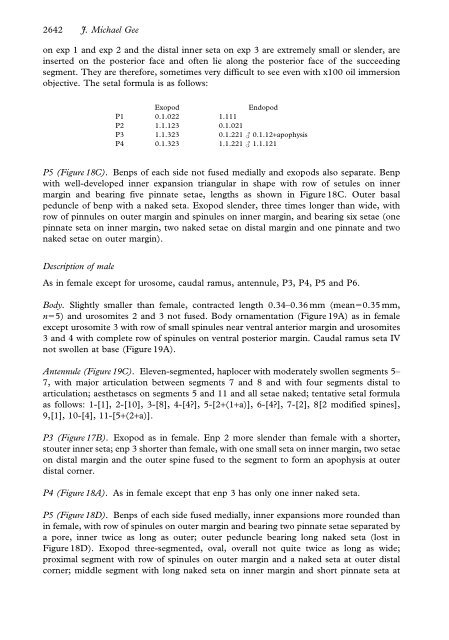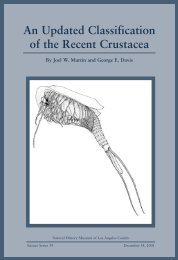Parastenheliidae (Copepoda: Harpacticoida) from ... - Luciopesce.net
Parastenheliidae (Copepoda: Harpacticoida) from ... - Luciopesce.net
Parastenheliidae (Copepoda: Harpacticoida) from ... - Luciopesce.net
You also want an ePaper? Increase the reach of your titles
YUMPU automatically turns print PDFs into web optimized ePapers that Google loves.
2642 J. Michael Gee<br />
on exp 1 and exp 2 and the distal inner seta on exp 3 are extremely small or slender, are<br />
inserted on the posterior face and often lie along the posterior face of the succeeding<br />
segment. They are therefore, sometimes very difficult to see even with x100 oil immersion<br />
objective. The setal formula is as follows:<br />
Exopod<br />
Endopod<br />
P1 0.1.022 1.111<br />
P2 1.1.123 0.1.021<br />
P3 1.1.323 0.1.221 „ 0.1.12+apophysis<br />
P4 0.1.323 1.1.221 „ 1.1.121<br />
P5 (Figure 18C). Benps of each side not fused medially and exopods also separate. Benp<br />
with well-developed inner expansion triangular in shape with row of setules on inner<br />
margin and bearing five pinnate setae, lengths as shown in Figure 18C. Outer basal<br />
peduncle of benp with a naked seta. Exopod slender, three times longer than wide, with<br />
row of pinnules on outer margin and spinules on inner margin, and bearing six setae (one<br />
pinnate seta on inner margin, two naked setae on distal margin and one pinnate and two<br />
naked setae on outer margin).<br />
Description of male<br />
As in female except for urosome, caudal ramus, antennule, P3, P4, P5 and P6.<br />
Body. Slightly smaller than female, contracted length 0.34–0.36 mm (mean50.35 mm,<br />
n55) and urosomites 2 and 3 not fused. Body ornamentation (Figure 19A) as in female<br />
except urosomite 3 with row of small spinules near ventral anterior margin and urosomites<br />
3 and 4 with complete row of spinules on ventral posterior margin. Caudal ramus seta IV<br />
not swollen at base (Figure 19A).<br />
Antennule (Figure 19C). Eleven-segmented, haplocer with moderately swollen segments 5–<br />
7, with major articulation between segments 7 and 8 and with four segments distal to<br />
articulation; aesthetascs on segments 5 and 11 and all setae naked; tentative setal formula<br />
as follows: 1-[1], 2-[10], 3-[8], 4-[4?], 5-[2+(1+a)], 6-[4?], 7-[2], 8[2 modified spines],<br />
9,[1], 10-[4], 11-[5+(2+a)].<br />
P3 (Figure 17B). Exopod as in female. Enp 2 more slender than female with a shorter,<br />
stouter inner seta; enp 3 shorter than female, with one small seta on inner margin, two setae<br />
on distal margin and the outer spine fused to the segment to form an apophysis at outer<br />
distal corner.<br />
P4 (Figure 18A). As in female except that enp 3 has only one inner naked seta.<br />
P5 (Figure 18D). Benps of each side fused medially, inner expansions more rounded than<br />
in female, with row of spinules on outer margin and bearing two pinnate setae separated by<br />
a pore, inner twice as long as outer; outer peduncle bearing long naked seta (lost in<br />
Figure 18D). Exopod three-segmented, oval, overall not quite twice as long as wide;<br />
proximal segment with row of spinules on outer margin and a naked seta at outer distal<br />
corner; middle segment with long naked seta on inner margin and short pinnate seta at











